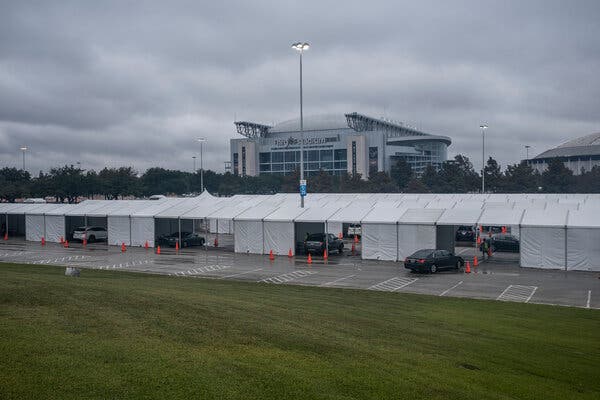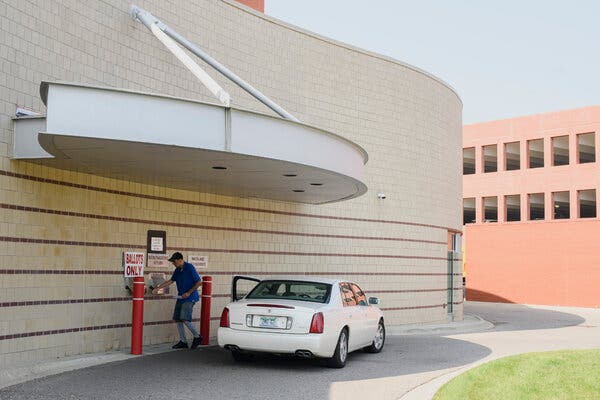Advertisement
Federal district courts have tended to rule for Democrats in litigation over how to run the election, but appeals courts, well stocked with the president’s nominees, are blocking them.

This month, a federal judge struck down a decree from Gov. Greg Abbott of Texas limiting each county in the state to a single drop box to handle the surge in absentee ballots this election season, rejecting Mr. Abbott’s argument that the limit was necessary to combat fraud.
Days later, an appellate panel of three judges appointed by President Trump froze the lower court order, keeping Mr. Abbott’s new policy in place — meaning Harris County, with more than two million voters, and Wheeler County, with well under 4,000, would both be allowed only one drop box for voters who want to hand-deliver their absentee ballots and avoid reliance on the Postal Service.
The Texas case is one of at least eight major election disputes around the country in which Federal District Court judges sided with civil rights groups and Democrats in voting cases only to be stayed by the federal appeals courts, whose ranks Mr. Trump has done more to populate than any president in more than 40 years.
The rulings highlight how Mr. Trump’s drive to fill empty judgeships is yielding benefits to his re-election campaign even before any major dispute about the outcome may make it to the Supreme Court. He made clear the political advantages he derives from his power to appoint judges when he explained last month that he was moving fast to name a successor to Justice Ruth Bader Ginsburg so the Supreme Court would have a full contingent to handle any election challenges, which he has indicated he might bring in the event of a loss.
In appointing dozens of reliable conservatives to the appellate bench, Mr. Trump has made it more likely that appeals come before judges with legal philosophies sympathetic to Republicans on issues including voting rights. The trend has left Democrats and civil rights lawyers increasingly concerned that they face another major impediment to their efforts to assure that as many people as possible can vote in the middle of a pandemic — and in the face of a campaign by Republicans to limit voting.
“There has been a very significant number of federal voting rights victories across the country and those have in the last week or two — many if not most — been stayed by appellate courts,” said Wendy R. Weiser, the director of the Democracy Program at the Brennan Center for Justice at New York University, which has been involved in several voting rights lawsuits this year. “We’re seeing the brakes being put on the voting rights expansion at the appellate level in these jurisdictions, in many cases in ways that won’t be remediable before the election.”
In potentially pivotal states like Wisconsin and Ohio, the outcomes appear to be serving the president’s effort to limit voting while in some cases creating widespread confusion about the rules only three weeks before Election Day.
There has been a dizzying amount of election-related litigation this year, with more than 350 cases playing out in state and federal courts. In general, the disputes focus on how far states can go to make it easier to apply for, fill out and send in mail ballots, and how much time election officials can take to count what is certain to be a record number of them. In polls, Democrats have indicated that they are more likely than Republicans to vote by mail this year.
Democrats and civil rights groups have argued that certain provisions regarding ballots that may have made sense before the pandemic are unduly onerous in light of social distancing guidelines and delays throughout the badly overwhelmed Postal Service. Those include requiring excuses and witness signatures for absentee ballots, having strict Election Day deadlines for the official receipt of mail votes and the limited use of drop boxes.

Republicans, led by Mr. Trump, have argued that easing those rules or expanding the use of drop boxes would leave the voting system so open to fraud and chaos that it would threaten the very legitimacy of the election.
A series of rulings handed down in the late summer and early fall rejected that argument, pointedly noting the dearth of evidence that fraud poses anything close to the threat the president and his Republican allies say it does.
“The state did not provide any actual examples of voter fraud,” Judge Robert Pitman, an appointee of President Barack Obama, ruled in blocking Mr. Abbott at the district court level from limiting drop boxes in Texas, where Democrats have made substantial inroads in recent years.
“The record shows that voter fraud rarely occurs today,” another district court judge nominated by Mr. Obama, Abdul K. Kallon, ruled in easing balloting requirements in Alabama, where Republicans are hoping to unseat the Democratic incumbent, Senator Doug Jones.
“No evidence was introduced at the hearing to support the conclusory reference to fraud,” Judge Dan Aaron Polster, a Clinton appointee to a district court, wrote in rejecting attempts to limit drop boxes in Ohio, a state that Democrats believe they might be able to swing to their column in the presidential election.
Appeals courts stayed those decisions in Texas, Alabama and Ohio, as well as a similar ruling in Wisconsin that had extended deadlines for mail-in ballots. The decisions in the cases came from panels including judges appointed to the appeals courts by Mr. Trump.
A state court case in Pennsylvania extending the deadline for the receipt of mail-in ballots, as well as the federal one in Wisconsin, is now in front of the U.S. Supreme Court, which, with the expected confirmation of Judge Amy Coney Barrett, is likely to soon have a more decisive conservative majority.
Election 2020 ›
What You Need to Know About Voting
- How to Vote: Many voting rules have changed this year, making it a little trickier to figure out how to cast your ballot. Here’s a state-by-state guide to make sure your vote is counted.
- Three Main Ways to Vote: We may be in the midst of a pandemic, but whether you vote in person on Election Day, a few weeks early, or prefer to mail in your ballot this year, it can still be a straightforward process.
- Do You Still Have Time?: Voters in 35 states can request ballots so close to Election Day that it may not be feasible for their ballots to be mailed to them and sent back to election officials in time to be counted. Here’s a list of states where it’s risky to procrastinate.
- Fact-Checking the Falsehoods: Voters are facing a deluge of misinformation about voting by mail, some prompted by the president. Here’s the truth about absentee ballots.
Voting rights lawyers are bracing for the possibility of further 11th-hour uncertainty depending on the Supreme Court’s ruling in the Pennsylvania case, which could clear the way for even more state-level cases to find their way into the federal court system.
The appeals court rulings and some of the decisions by the Supreme Court have been generally based on notions that federal courts should not render decisions affecting state voting provisions too close to elections, and that courts should be hesitant to override local voting laws concerning election deadlines and ballot requirements.
Mandi Merritt, the national press secretary for the Republican National Committee, celebrated the party’s victories on appeal, portraying them as necessary checks on what she called the Democrats’ “radical attempts to overhaul our election system” and gut “election integrity” laws.
Lawyers from both sides are loath to ascribe partisan motives to sitting judges. And the decisions have sometimes defied ideological identities.
For instance, in Minnesota, a federal judge appointed by Mr. Trump rejected Republican attempts to roll back a mail-in ballot extension deadline, just as a Trump-appointed federal judge supported an agreement in Rhode Island to suspend the state’s strict rules requiring ballots have two witness signatures or notarization. The Supreme Court rejected a Republican challenge to the Rhode Island ruling in a decision in which Chief Justice John G. Roberts Jr. and Justice Brett M. Kavanaugh chose not to join a dissent by their three fellow conservatives.
Nonetheless, Mr. Trump has significantly affected the balance of the federal bench. Since taking office, Mr. Trump prioritized picking judges for the appeals court, with his selections appearing to trend more reliably conservative than past Republican appointees and now accounting for more than 25 percent of all active appellate judges.
“One of the stories of the Trump administration has been a laserlike focus on getting young, ideologically conservative judges on the courts of appeals,” said Russell Wheeler, a visiting fellow at the Brookings Institution and a former deputy director of the Federal Judicial Center, the research and education arm of the federal court system.
Broadly speaking, when it comes to voting rights, modern conservative jurisprudence tends to be wary of federally imposed, race-based protections — enacted to eradicate decades of intentional disenfranchisement — and prioritizes the rights of states to impose restrictions to prevent fraud, despite what evidence may show or fail to show, above the need to protect access to voting.
Progressive activists who have pushed for an expansion of the Supreme Court funded a recent study that found a partisan pattern in voting-rights rulings, concluding that Trump appointees had made what it called “antidemocracy” decisions in 85 percent of the election-related cases they heard.
“Elections have consequences, and the circuit courts are now more conservative than they were when Donald Trump took office,” said Nathaniel Persily, a professor at Stanford’s law school who specializes in voting rights and election law. “We should not be surprised that the panels, on average, are now going to be more conservative in the way they adjudicate these voting cases.”
Mr. Trump has shifted the ideological balance of two particular appeals courts with jurisdiction over states that could ultimately decide the election: the Third Circuit, which covers Pennsylvania, and the 11th Circuit, which covers Florida and Georgia.
He has also significantly eaten into the liberal majority in the Ninth Circuit, which includes the competitive states of Arizona and Nevada.
Though the circuit overseeing Texas has long been known for its conservatism, the three Trump appointees who issued the recent decision on drop boxes have been particularly formidable allies for Republicans.
Democrats indicated that they were basing their strategy for the final phase of the campaign around the notion that they were unlikely to win, at least consistently, at the federal appeals court level and the Supreme Court. They said they were hoping to run up margins that were too big to overcome through legal challenges.
“Plan A is to win so decisively that marginal litigation can’t affect the outcome,” said Ben Wikler, the chairman of the Wisconsin Democratic Party.
Some Democrats said they were concerned that court decisions in the days or weeks just before Election Day could cause confusion that Mr. Trump might try to exploit while challenging a losing result. (For instance, a state judge in Texas on Thursday ruled against Mr. Abbott’s restrictions on drop boxes, effectively countermanding the federal appeals decision and leaving the matter unclear before the election next month.)
The higher the level of confusion, Mr. Persily said, the more likely that final results could wind up before judges.
“The most important thing is that we have clear rules right now about how this election is going to be conducted,” he said. “While there are good rules and bad rules, it’s better to have a rule than no rule at all. The more uncertainty that the courts are injecting into the process right now, the greater the likelihood there will be postelection litigation.”



